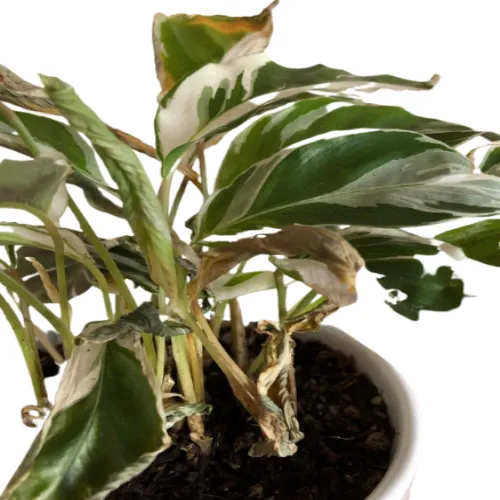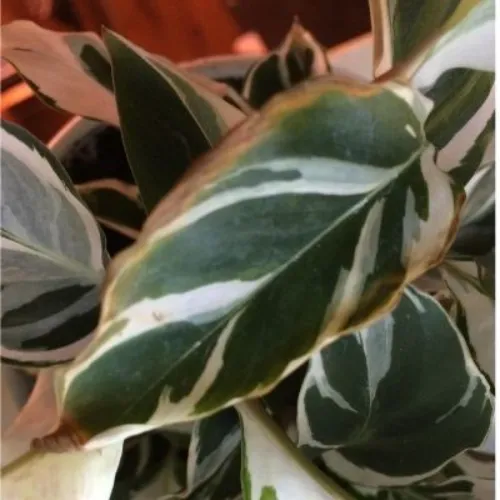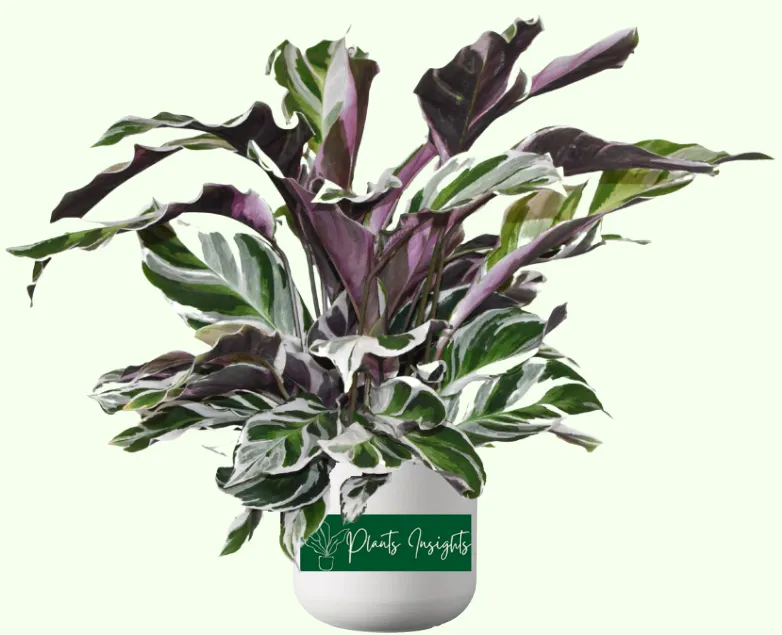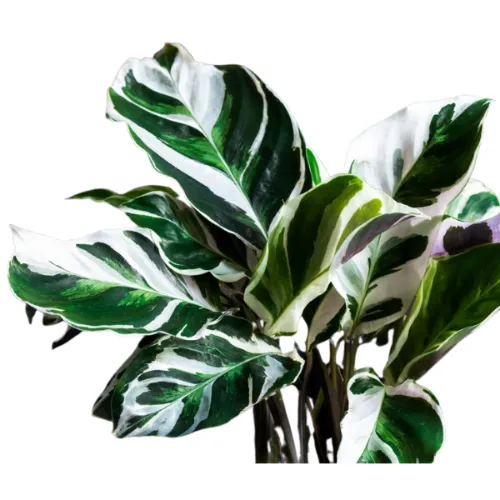Calathea plants are famous for their attractive evergreen foliage. If you are fond of collecting leafy tropical plants, then this gorgeous specie of Calathea Fusion White is a must for you. As the name indicates, it has a white colour fusing with green on glossy leaves and underside with light purple, giving it a stunning watercolour painting marble effect.
White Fusion Calathea is slightly difficult to grow and more sensitive towards light than other plants, but it will keep flourishing in your house with good care and guidance. You must be more attentive to White Calathea than other house plants as they require much humidity and indirect medium light.
Prominent Family Members: Calathea Medallion, Calathea Zebrina, Calathea Rufibarba, Calathea Ornata, Calathea Orbifolia, Rattlesnake Plant, Calathea Louisae
Essential Products:
How to care for Calathea White Fusion?
This plant requires extra care and attention compared to Calathea Zebrina and Calathea Freddie. Calathea white fusion care guideline is a must to follow to keep this stunning showpiece alive. The plants are quite sensitive to the water they are given and the kept area. For soil, always use a moisture meter to check the moisture level.
It is recommended to provide it with an area with diffused light, with lots of humidity, to check the humidity level using a hygrometer. Make a permanent spot to display it in your house. We will provide you with some extra information and tips to keep it healthy and fast-growing.

Bringing the White Calathea to home
When you bring White Calathea to your home, don’t forget to check it thoroughly, plants are often contaminated with viral disease or have pests on them. Keeping them with your indoor plants might affect the other healthy plants.
Stunning colors of White Fusion
We recommend keeping the plant separately in an airy, bright shady place with perfect humidity. Keep checking it daily, and if you notice any unusual sign of diseases or pests, then mitigate it with proper medicine or pest spray; after two weeks, you can add it to your house decor.

Humidity and Temperature
Although White Fusion Calathea remains healthy in humid and warm places, sudden temperature changes can affect it badly. For instance, in winter, you may keep your home warm with a heater; however, the room may become too cold at night. These types of sudden changes are not good for Calathea plants. Please take special care to maintain the temperature at which the plant is flourishing. The Ideal temperature for the Fusion White Calathea is 60°F – 77°F.
The heater will be the main factor in reducing the surrounding humidity level in winter. The humidity level in the atmosphere for the plant must be 60%. Place the hygrometer near the plant to check its humidity level. If it’s less than 60%, create more humidity with a plant humidifier or create a mist around it.

Soil Requirements for Fusion White
If you want to see your White Fusion Calathea plant growth healthy, then the soil must be airy and have well drainage. We recommend using a soil mix that comprises of 50% potting mix soil, 50% peat, perlite, and organic matter.
Don’t use regular potting soil since it has poor drainage quality, but you can improve it by adding more components like tree bark and perlite. Calathea Fusion loves to grow in moist soil; therefore, the soil mix shall be moisture-retaining. Some new gardeners get confused by soil being well-draining as well as moisture-retaining because both properties seem opposite to a novice person.
However, the point is that soil shall absorb the moisture to keep the soil damp and should be able to drain any excess water. These properties are achieved by adding peat and perlite, where the former helps increase the moisture-retaining capability of the soil, whereas the latter makes the soil well-draining.
If you feel too overwhelmed by all the stress of making your soil mix, you can always purchase ready-made from your nearest garden store or online. A readily available African Violet mix is best suited for your White Fusion Calathea.

How much light does a White Fusion need?
Calathea White Fusion requires abundantly diffused bright light. Select a shaded area for best growth. Like its family members Calathea Musaica and Warscewiczii, this Calathea is also sensitive to direct sunlight. Direct sunlight will decolorized and fade the beautiful leaf’s color, or they may start curling due to exposure.
We recommend growing the plant under big trees in your garden or shaded areas like your balcony if you intend to grow it outdoors. This practice will mimic their natural environment where they happily live under the canopy of trees in tropical forests; that’s why they love shaded areas.

Watering Requirements of White Fusion Plant
White Fusion Calathea require water mostly twice a week watering in summer and weekly in winter because the growth rate is slow in winter.
Use a moisture meter to check soil moisture and if you don’t have the meter, then put your finger in the soil up to one inch. If the soil is dry below, your plant requires water. If it’s damp below one inch, stop watering it to avoid root rot. They require moist soil, not wet or soggy, which leads to roots rotting and makes the plant start to wilt.
Overwatering, signs are yellowing and browning of leaves. If you see these changes in your Fusion White Calathea immediately repot the plant with dry soil. If the plant stays prolonged in wet or soggy soil, root rot will occur, and it will be prone to fungal and viral disease.
A watering routine that maintains the soil moist and slightly damp will keep your plant happy.
Water the White Fusion Calathea with distilled water or rainwater; they are sensitive to chemicals, so don’t give them hard water. Please ensure not to give too cold or too hot water, and its temperature should be normal room temperature.
Keep checking the pot’s water drainage hole for blockage so that the water will not be gathered in the bottom of the soil and flow away.

Fertilizing the White Calathea
Nitrogen-rich fertilizer will support the Calathea White Fusion Plant in the growing season, which is spring and summer. Make a liquid solution with the right concentration according to the instructions written on the fertilizer bag.
The plant becomes dormant in the winter; therefore, it does not require fertilizing. Please be aware that overfertilizing can burn the delicate leaves of your Fusion White Calathea. Calatheas prefer not to be fertilized rather than overfertilized. Therefore, if you are not sure, dilute the common houseplant nitrogen-based fertilizer to one-quarter of strength.

Pruning of White Calathea
Pruning is a cutting down of the plants’ leaves and branches to jump-start the new growth. Calatheas White Fusion does not require much pruning other than removing affected and yellow leaves from the plant. If your Calathea Fusion White leaves turn yellow, dying, dead, affected by the disease, or decolored, then it’s time to prune the plant.
We recommend carefully inspecting the plant occasionally and cutting any leaves with spots, curling, or brown edges. You should not be worried about removing such leaves because new leaves will grow soon if the plant is placed in a favorable environment under a good care program. Just cut that leaf from the stem with sterilized scissors, shear or remove it with the hand.

Is Calathea White Fusion pet friendly?
Calathea White Fusion is a non-toxic plant and entirely safe for pets and humans. White Fusion leaves are beautiful, and pets and kids are attracted to them alike. There could be an instance where pets or kids chew on the leaves. Consumption of leaves in large quantities regardless of their non-toxic nature can be harmful to pets and kids. Therefore keep an eye on when kids or pets are playing around your houseplants.

Propagation of Calathea Fusion White
The best time to propagate Calathea White Fusion is when you repot the plant in the spring season. Contrary to other popular Calathea family members, White Fusion can also propagate via leaf nodes and seeds. In Summer, plant growth is fast, and more new plants can be made by dividing the mother plant roots if it is healthy and fully thrived.
You can maintain the plant size through propagation and provide more space to blossom. Calathea’s mother plant can also be divided into two, three, or four parts; however, it depends on the foliage’s richness.
Propagation through Roots
Propagation through Leaf Node
To propagate Calathea White Fusion through leaf node, you need to have a pair of scissors, a healthy mother plant, a 4-inch pot filled with good drainage with pot soil, and a bright and clean area for work.
Now follow the following scheme for propagation through the leaf node.
Propagation through Seed

Repotting White Calathea
We recommend repotting Fusion White Calathea once a year to give roots enough space to grow. Keep these things in mind when you are going to report your plant:

Common Pests & Plant Diseases
Calathea species are commonly affected by fungal diseases because a humid environment enhances fungal growth and infection. So, if your plant leaves are infected by fungal disease, use Neem oil to restrain the infection. Mealybugs, spider mites, scale, and aphids commonly infect the Calathea white fusion plant and can easily be removed by insecticides.
Calathea white fusion requires a humid atmosphere that makes him prone to bacterial infection. It might be Pseudomonas bacterial infection if you notice white round blemishes on leaves. If these leaves are not separated, the infection spreads and infects the entire plant.
Three types of Fungi mostly infect Calathea species’ roots. If your White Fusion Calathea lower leaves start turning yellow near the soil, and the growth rate is also slow, it might be soil-borne fungus infection on roots. Some other factors may cause Root rot, but fungal infection is normally the reason. Waterlogged soil supports fungal growth; it spreads fast and infects the roots. The damage, if left unattended, will spread and starts infecting the stem and the entire plant.
Use copper and sulfur-based fungicide to get rid of these diseases.
White Calathea Problems and Queries
Calathea white fusion plant needs a favorable condition to have a healthy look, watering routine, moisture level, accurate, warm temperature, and bright diffused light will make this plant flourish dynamically. Minor neglection will result in these problems.
Calathea Root Rot
Overwatering, poor drainage soil or drainage hole blockage will lead to root rot of the plant. Any of the following symptoms indicate your plant could be facing a root rotting problem.
How to fix Root Rot?
Why is my White Fusion turning yellow?
The main reason Calathea Fusion White leaves turn yellow is the overwatering of the plant. Please have a review of your watering frequency, and check the soil for dryness before watering. If the topsoil is not dry, do not water the plant.

Calathea Fusion White Leaves Yellowing
The second factor can be root rot. If yellow leaves start wilting or develop white or brown spots and fall quickly, then your plant is infected by a fungal pathogen.
How can you know if root rot is the cause of the yellowing of the leaves? If the plant grows in water-logged soil and the leaves are yellowing quickly with wilt, droop, or brown spots, root rot is the culprit.
Why my Fusion White Calathea Leaves are turning brown?
If your plant leaves start turning brown from the edges, lack of humidity is normally the cause of this problem. Provide the plant with adequate humidity to resolve the issue. You can either use a humidifier or use DIY techniques like pebble water trays to solve the problem.

Calathea Fusion White Leaf Turning Brown
Is Calathea White Fusion difficult?
Calathea White Fusion requires more attention than other easy-to-care Calatheas like Rattlesnake plant and Calathea Freddie. Overall white fusion needs intermediate care, and with little effort, the plant can thrive and brighten your home with the spectacular contrasting foliage.
The main aspects to look for; developing an optimum watering schedule that keeps the moist soil but not too wet, placing the plant in indirect sunlight, maintaining humidity above 50% around the plant, and temperature between 65F – 75F.
Where do you put Calathea White Fusion?
Calathea White Fusion originates from the rainforests of the Amazon. The plant naturally grows under the shade of larger trees, where it gets diffused sunlight. Therefore, the Fusion White plant shall be placed to get indirect bright sunlight. The perfect place in our homes would be a few feet away from sunlight receiving windows where the plant will not receive direct light. Never put the plant in direct sunlight as it can burn the plant leaves.
Another aspect is to look for changes in the surrounding temperature. The plant does not favor abrupt variations in ambient temperature, therefore keep the plant away from locations where it can get a cold draft from outside or direct heat from the internal heating system.
Is Calathea White Fusion rare?
Calathea White Fusion has variegated leaves with stunning white spatters. Typical White Fusion is not rare, and you can easily find it at local plant shops and online on Amazon and Walmart. However, some varieties of Calathea White fusion are challenging to find. For instance, a Fusion White Calathea variation having leaves with lilac shade in between white splashes is a rare beauty to discover.
Why is my White Fusion dying?
Deterioration in White Fusion Calathea’s health can be because of several reasons. First, look for the symptoms for the correct diagnosis of the problem. If your White Fusion leaves have excessive yellowing most probable cause is over-watering. Reduce the water input to plant and water only when the soil has partially dried. Please ensure the water drain hole in the pot is not blocked.
Moreover, root rotting can be involved if the yellowing of leaves is more evident at the bottom near the roots. Inspect the roots and if you notice a sign of rotting, remove the damaged roots and repot the plant in fresh soil. If the leaves’ edges are brown colored, the plant is not getting enough humidity. Increase your indoor humidity level using a humidifier to resolve the issue, or place the plant in a more humid area like a washroom. If the leaves midspan is discolored, too much sunlight could be the reason.
Does a White Fusion flower?
White fusion plant produces tiny white, yellow, and purple flowers in the wild; however, it is unlikely for Fusion plant to bloom indoors. Additionally, it is the patterned variegated foliage for which White Fusion is famous for not the flowers. Plant blooms are odorless and as attractive as the foliage. If you become successful in making your White Calathea bloom indoors, it means you have taken outstanding care of the plant.
Why is my Calathea White Fusion leaves curling?
Calathea Fusion leaves curl when exposed to high temperatures. Leave curling is a defense mechanism triggered to reduce evaporation of moisture when plant losses its water due to heat exposure. Eliminate the high-temperature reason or shift the plant to a cooler place to resolve the problem.


